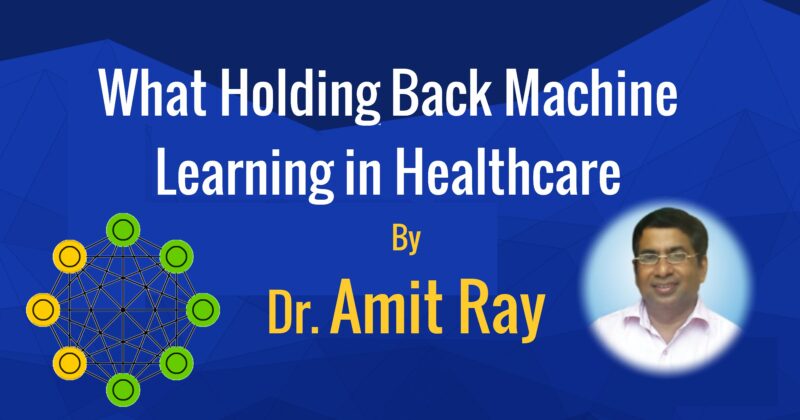What is holding back the large scale implementation of machine learning systems in healthcare and precision medicine? In this article Dr. Amit Ray, explains the key obstacles and challenges of implementing large-scale machine learning systems in healthcare. Dr. Ray argued that lack of deeper integration, incomplete understanding of the underlying molecular processes of disease it is intended to treat, may limit the progress of implementing large-scale machine learning based reliable systems in healthcare. Here, nine obstacles of present day machine learning systems in healthcare are discussed.

Machine Learning in Healthcare
Recently, machine learning algorithms, especially deep learning has shown impressive performance in many areas of medical science, especially in classifying imaging data in different clinical domains. In academic environment, Deep learning and Reinforcement learning methods of Artificial Intelligence (AI) has shown tremendous success in numerous clinical areas such as: Omics data integration (such as genomics, proteomics or metabolomics), prediction of drug-disease correlation based on gene expression, and finding combinations of drugs that should not be taken together. Deep learning is very successful in predicting cancer outcome based on tumour tissue images. Machine learning are used for medical decision support systems for ICU and critical care. Artificial Intelligence in Healthcare Current Trends discusses the current status of AI in healthcare.
In radiology, deep learning tools become more sensitive and are able to identify small image variances that are not visually discernible by the human eye, they may have the potential to enable earlier diagnosis of disease. Deep learning are now used to predict epigenetic phenomena and associated diseases.
Machine learning (ML) is now one of the most powerful and promising tool, which can enhance every stage of patient care—from research, drug design and discovery to diagnosis and selection of appropriate therapy. Now, ML supported messaging apps and voice controlled chatbots are also helping people to take off the burden on medical professionals regarding easily diagnosable health concerns or quickly solvable health management issues. However, there are many obstacles and number of issues remain unsolved.
By offering automation, intelligence, learning and accuracy beyond human ability, ML enhances the value of data beyond what humans can accomplish. However, the power of ML is limited by its dataset. If data does not contain many strong predictors of heart failure, it will remain totally ignorant about that. Collection of reliable data is pushing the implementation of ML in real life patient care systems far away. Even with so many success and promising results its full application in health care is limited. There are multiple issues to be resolved before the full scale introduction of deep learning methods in medical practices. Here, we discussed nine key issues of machine learning in healthcare. The details are as follows:

1. Lack of High Quality Datasets
Most of the experimental datasets that are often available are good for concept validation, prototype development and academic research and experimentation but they are far away from the requirements of exhaustive diagnosis, drug analysis and discovery in real life situations. Even a perfect model is limited by the quality and magnitude of signal in the dataset from which it is trained. The model can only be as good as the relevant information in the dataset. Both the breadth and depth for training data in a particular application are essential, but frequently it is difficult to get real life data due to privacy concerns, and record identification concerns.
2. Lack of Depth in Training Dataset
The training data for deep learning must cover both vertical and horizontal depth of conditions and diseases. It is difficult to determine how much data and training a neural network requires, it is agreed that large datasets are required in order to reach acceptable levels of accuracy and performance. But how the system will behave in boundary conditions is not predictable. Additional extrapolated synthetically modified data are not serving the purpose. Moreover, algorithms must be trained separately for each condition and disease.
3. Lack of Explanation and Interpretation Ability
Even though the ML methods showing excellent results, in numerous occasions, it is difficult or mostly impossible to explain the technical and logical bases of the system. The black box nature of the current deep learning techniques unable explain, the logic behind the conclusions or the results it has reached. The current ML is not capable of abstracting concepts from limited experience and transferring knowledge between domains.
The new General Data Protection Regulation (GDPR) laws states that data subjects have the right not to be subject to a decision based solely on automated processing that produces legal or similarly significant effects. Individual has the rights to know information about the logic involved, as well as the significance and the envisaged consequences of such processing for the data subject.
4. Problems of Over-fitting and Under-fitting
One of the problems with machine learning, including deep learning, is overfitting. Overfitting occurs when the trained model does not generalize well to unseen cases, but fits the training data well. This becomes more apparent when the training sample size is small.
Assessment of the training curve can be used to assess the possibility of overfitting. From the curve, it is often apparent that the data loss is similar for both validation and training datasets, which indicates well-fit curves. If there were overfitting, the loss on the training data would be much greater than that of the validation data. Dropout, model regularization and other strategies are helpful to overcome this issue. But in real life large-scale application it is still a crucial issue.
5. Lack of Reproducibility of Results
In medical research, credibility is of utmost importance. Transparency and reproducibility of the results are vital. Reproducibilty can also be applied under changed conditions of measurement. With more and more complex studies, advanced statistics, and the constant pressure on researchers to publish, there is a growing concern about scientific transparency and the challenges with irreproducible research.
Lack of standardization, particularly regarding data interchangeability and manipulation and reproducibility of results. One major stumbling block to the advancement of result validation has been the lack of a standard test set agreed upon and used by the entire community. The researchers often significantly process and manipulate the data before using them as input for learning programs. There is a need for standardization of workflow, and validation and testing systems which can divide into a series of standard protocols.
6. Ethical challenges and legal issues
Who is to blame if a smart algorithm makes a mistake and does not spot a cancerous nodule on a lung X-ray? To whom could someone turn when the systems comes up with a false prediction? Who will build in safety features so machine will not turn on humans? What will be the rules and regulations to decide on safety?
There could be legal and ethical issues regarding the use of clinical imaging data for the commercial development of deep learning based system, since the performance of the system will be highly dependent on the quality of the data.
The use of ML in health care raises many ethical issues, including: the potential for machine to make erroneous decisions; the question of who is responsible when algorithms are used to support decision-making; difficulties in validating the outputs of machine learning systems; inherent biases in the data used to train the systems; ensuring the protection of potentially sensitive data; securing public trust in the development and use of ML technologies; effects on people’s sense of dignity and social isolation in care situations; effects on the roles and skill-requirements of healthcare professionals; and the potential for ML to be used for malicious purposes.
7. Lack of Integration: a synergistic approach to health care
Integration of machine learning techniques at various levels of diagnosis and decision making is key to success. Dynamics of multi-diseases, effects of multi-drugs, impact of environments and cultures are to be studied to include them in the machine learning algorithms. Different types of medical data have their own predictive value, representative sensitivity, prediction rates and weights. Each type of data (basic blood test, basic urine test, MRI, electroencephalogram, electrocardiogram, genome, transcriptome, microbiome etc.) and their combinations have relevant value, depending on quality of the medical records and its biological significance for certain disease condition.
Various patterns reflecting the changes in patient condition are more readable when doctor operates complex information, presenting patient health state on different levels at the current period of time. Normally, changes in patient conditions should be incorporated in the ML system testing and validation. Some of the data types, like images, audios, and videos can also have substantial predictive value for medical conditions. The evaluation methods to test the performance of each individual technique as well as integrated techniques requires many developments.
Finally, incorporating and integrating the political intelligence and dynamics of the pharmaceutical companies, health insurance companies, hospital administrators, government bodies, research institutes, doctors, and lastly incorporating the emotions, financial conditions and disease conditions of the patients in the machine learning models are real challenge.
8. Lack of Empathy and Compassion
Concerns have been raised about a loss of human contact and increased social isolation if machine learning technologies are used to replace staff or family time with patients. Machine learning may cover the whole process of treatment, However, empathy, proper communication and the human touch are still equally important and essential.
9. Stopping the Malicious Uses
ML is becoming essential technology for healthcare and can benefit us in numerous ways. However, we are increasingly aware that they can be used for nefarious purposes by malicious actors. This is something that we should all remain vigilant of, as these technologies also have the potential to undermine our conventional defenses. It is always inevitable that, sooner or later, such a powerful technology would be used for malicious purposes. The malicious actors can take advantage of the machine learning process and taint the data pool from which these systems learn. The challenge is to design and develop self-learning and self-protective systems that can identify the malicious code, or data at the early stage.
Summary:
Deep learning and other machine learning techniques are increasingly showing superior performance in many areas of clinical medicine compared to human experts and are able to predict and diagnose diseases from many complex data with higher speed. However, there are many obstacles and number of issues remain unsolved for implementing large-scale integrated machine learning systems in healthcare.
Here, we discussed nine critical issues for implementing large-scale machine learning applications in healthcare. Best practices should be identified in research areas with more mature methods for addressing the issues. High quality training datasets are key to success. Medical expert-in-the-loop at various levels of system development, testing and validation may improve not only the way input datasets are selected and predictive performance is evaluated, but also they could guide the learning process in better ways.
Source Books:
-
- Compassionate Artificial Intelligence: Frameworks and Algorithms by Dr. Amit Ray
- Compassionate Superintelligence, AI 5.0 by Dr. Amit Ray
- Artificial Intelligence for Precision Medicine By Dr. Amit Ray
- Quantum Computing Algorithms for Artificial Intelligence By Dr. Amit Ray
